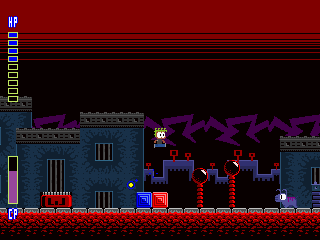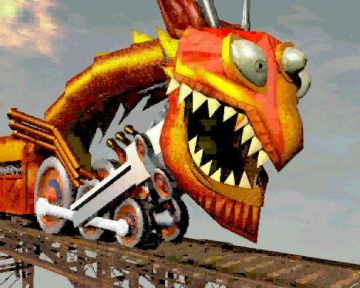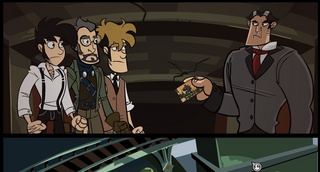The year of Jeans
A couple of slightly self-centered paragraphs before going on to the games, seeing as 2008 has marked sort of a culmination where many of my previous social, ideological and professional achievements paid off in some degree to give me a review of what I’ve done so far. With the risk of sounding like I’m bragging, it’s been a year where I’ve been to 4 foreign countries on 3 different continents, been honored with the “Alumni of the year” at Gotland University’s Game Development education and for the first time in my life has consistently made more money than I could reasonably spend – a very ironic situation considering the world economy, and something that could well be foreboding of darker times to come, as if 2008 was the very peak of this part of my life. I don’t fret, though, as I prefer some challenge.
I hope to turn my attention back to my craft in 2009, both by advancing in my work (something that has been very slow in 2008) and by developing my own ideas further, to what degree both of these goals are possible. While 2008 was a year of stepping back and enjoying what I had accumulated, this didn’t translate to development and I have yet to take advantage of the fact that I now have every opportunity to create games that I passed on five years ago due to lack of programming ability. Hopefully 2009 will give me time to pick up that thread again as well as further my professional career. But really, enough ranting.
World of Goo feels alluringly simple every time I start it, but yet I keep starting it just to replay a few levels here and there. The core mechanic is very simple and it feels very solid and responsive – even though you can use the intuitive physics to device your own crazy ways to solve each puzzle. As such, the game is open to experimentation and has a high replay value, but also low in frustration making it hard to stop playing.
Mirror’s Edge introduced something immensely cool into first-person games. Where jumping and running is traditionally something done out of necessity rather than to create new gameplay, Mirror’s Edge took the challenge to make platform gameplay work in first-person head-on. It’s far from a perfect game, but it feels like the things it does well could inspire better gameplay in so many other games.
Grand Theft Auto IV was a larger production than any other earlier game, and the level of coherency they managed to keep with so many people involved is mind-blowing. Compared to it’s predecessors, it is a more seamless blend of more varied gameplay elements, and the presentation of Liberty city is more alive than I’ve seen in any other game. Sure, it has it’s boring and repetitive parts, but it seems that’s what you trade for not being led by the hand through the entire game.
Christmas of Exploration

I somehow had more time than expected during the holidays so in order to pass time I started going through the “Metroidvania” category over at TIGdb, some of the higher-ranked games I had played already but when it comes to action-exploration I like the genre enough to forgive a few shortcomings. For any reader of TIGSource, this post will likely be completely worthless (and maybe even slightly offensive), but I will give some thoughts of my experiences – bearing in mind that I started playing each game expecting a hybrid of Symphony of the Night and Super Metroid.
An Untitled Story was the first game I played, and the only one I didn’t complete myself. Part of this was because it is a very large game, but also because it is very challenging in a “I Wanna be the Guy” – way with lots of precision jumping and unforgiving placement of savepoints, and when there was no more abilities to be acquired (ie: nothing more to explore) I felt I had gotten the parts I considered interesting. For a game with so simple presentation it is remarkably atmospheric and it beautifully captures the feel of exploration where every small path you unravel can lead to a whole new and interesting area.
Lyle in Cube Sector is a lot more reminiscent of NES exploration games and while I personally thought this made the entire map feel like a rather messy collection of similar rooms instead of a few distinct areas like in Untitled Story, the game itself was all the more interesting. The game revolved around cubes littering the landscape and all upgrades affected Lyle’s interaction with these cubes in some way for a fresh take on the genre. Lyle in Cube Sector also delivers on the traditional points, having a well-balanced difficulty curve, interesting boss fights and an engaging variety of enemies. The only other gripe I had was the lack of savepoints around the map (especially towards the end), but this was just a minor annoyance.
Painajainen was a much shorter game than the previous two, and also a rather odd entry in the bunch as it didn’t have any platforming, enemies or death. Instead of new skills, you flew around the gameworld finding small critters to follow you and have some effect of your immediate environment. It was sort of broken at times and the idea didn’t seem fully realized, but the athmosphere was nice and the originality of the approach prompts some interesting ideas.
Ikachan is a game by Daisuke “Pixel” Amaya, and though not as long or good as his Magnum Opus Cave Story, it is audiovisually similar and has another interesting approach that I would think influenced Aquaria, if only by very little. It is very short, and it knows it is very short so it is kind of sparse and doesn’t really get started – although it is a skill of Pixel to have a good sense of the scale of his project and make sure what’s there is polished, instead of having a too complex story and half-finished assets for a small game.
Plasma Warrior was the last game I played, and it was a rather straightforward game without much exploration, short like the previous two. The jumping felt a bit wobbly, but other than that it had some decent action elements. The description coins it as a “simple Metroid-style platform game” which says it all, really.
My favourite thing about Metroidvania games is the ingenuity in the design of a growing character – the map is littered with paths that you can clearly see as closed off to you in the beginning, so everytime you get a new skill/item the world you have already visited re-opens with new areas. This in turn makes character evolution very tangible without the need to represent it with icons or numbers, and constantly hints of a much larger world than you first can see and promises that you will get there eventually. When games hinder this progress by having overly difficult challenges – be they reflex- or puzzle-based, having long parts with no progress or force you to replay large parts, I usually feel they’re drifting from the brilliance of this design, but on the other hand I can’t discourage people from experimenting with mixing genres. Maybe what I should do is look for other games with metroidvania elements instead of metroidvania games with other elements.
Owlboy
Yes, I am late, and yes, I am a sucker for high quality, 16-bit style 2D graphics. But the Kid Icarus vibes are hard to resist.
Owlboy has been in development for quite some time now and seeing as they were looking for Beta testers in October it doesn’t seem far off. Though with what little information has been presented about the actual game, I’m remaining cautiosly optimistic.
Grim Fandango

It seems Tim Shafer will be allowed to release Brütal Legend after all, and although I really liked Psychonauts I hadn’t seen any of his other works so I decided to rectify this. Problem is, having completed it I am at a loss for words, so this post serves more as a reminder, a milestone of when I first played it, than a good description of what Grim Fandango actually is.
Apart from a few independent games, most notably Amanita Design’s Samorost, I don’t think I have ever really played an adventure game to the point where I felt I was getting somewhere before. Other games have adventure elements to be sure, but this would be like comparing the economy of Quake where you only really have to watch your ammunition, to that of Civilization where a number of variables factor in. My point is that Grim Fandango has some puzzles that by my standards were fiendishly difficult. Seeing as I’ve mentioned not wanting to waste my time when playing games before, I guess I could go into a rant about how it was easier to accept the tougher challenge when the picking was slimmer, but it seems somehow wrong to do this by starting out from Grim Fandango.
I mean, yeah, it’s difficult and I found myself trying every object on every other object more than a couple of times, but more than anything Grim Fandango is a game about the mood it sets, and walking around in the film-noir-esque melancholy of Tim Shafer’s world is a soothing experience that made me not mind the relentless brute-force problem solving so much. I think that is the greatness of this game.
Penny Arcade Adventures 2

It seems increasingly pointless to talk about separate parts of episodic game series in their own space, as once you have established the general rules the only apparent thing left to discuss is the differences between them. As for this particular title, it is slightly better in most ways – the graphics are slightly better, the jokes are a little more funny and the nods to the comic a little more frequent and the subquests are more varied. Battles are still somewhat tedious (though less frequent) though, and the bugs are still there (this time forcing me to restart the game a couple of times).
Penny Arcade Adventures has an appeal that’s not entirely different from that of most internet celebrities. While not a poor game, the only thing making it unique and it really has going for it is it’s style, so you’re wondering how long it will take before the creators either slip up or you find something more interesting; Although this question is largely hypothetical seeing as there is going to be a finite number of episodes. This “screw success” – attitude is refreshing in itself and Penny Arcade Adventure’s willingness to bring up excessive violence or other adult material without any apparent point is another example of it. It’s not genuinely different in every way, but at least in one.
Auditorium
Auditorium is a nice flash game currently in development, the general idea is the same as was presented in the Experimental Gameplay Project “Nexus” where you use the gravity generated from a number of objects to guide a stream towards a certain point. Auditorium expands on this to have several different types of objects manipulating the stream in different ways and several goals and sub-goals, but perhaps the most interesting feature is that for each goal you manage to hit another part of the background music plays so that you only hear the full version once you complete the level.
A very relaxing and enjoyable experience.
No More Heroes

No more heroes is one of those games that rely heavily on it’s own personal style. It is a parody of gaming culture and a pretty good one at that, but like other games where style took the lead, everything else has the backseat. Sure, the presentation isn’t really bad and the gameplay isn’t poor, but seeing how much energy developer Grasshopper put into establishing the style, the mediocrity of it becomes glaring.
The player is tasked with guiding the otaku Travis Touchdown who runs around swinging a lightsaber in order to prove himself as the top assassin in the United States, and this is done in 3rd- person action scenes in different environments. These action scenes is the part where No More Heroes really shines, as even though they aren’t very complex or challenging, there is a nice and balanced array of attacks at your disposal and the usual swinging-wiimote-controls are implemented in an intuitive and fun way. Problem is, between these levels No More Heroes imagines itself being GTA and tasks you with completing a number of minigames scattered around a city.
Now, one of the big problems I had with GTA was that a lot of the time driving around felt really pointless as getting from point A to point B posed no real challenge but took a considerable amount of time, and in no more heroes this problem is even more apparent since unlike GTA there is absolutely nothing else to do in the city. In addition to this, it seems the developers ran out of steam and was in a hurry to complete the game since the missions you undertake become shorter and shorter the longer you get in the game.
No more Heroes is by no means bad, and the combat is likely among the better implementations you’ll see on the Wii. It is, however, mediochre and seeing as there are really good games to play in it’s stead I don’t see the appeal – unless the idea of a game making fun of itself is enough.
Again with the review scores
Keith Stewart of the Guardian wrote an interesting piece a week back, about how Mirror’s Edge’s less than stellar review scores (and possible less than stellar sales as well) was due to nitpicking reviewers. According to Stewart, Mirror’s Edge should be forgiven for not included some things we take for granted in games since innovative titles seek to redefine those very things. A week later Newsweek’s N’Gai Croal wrote an equally interesting rebuttal to this and a couple of other articles, essentially saying that while prizing innovation is indeed a component of a review, a game can still have high production values (as shown by other innovative games having high scores) and disregarding those would be neglecting the point of reviewing the game.
On a personal basis I feel inclined to agree with Stewart and I don’t think Croal addresses his main point (if a game aspires to re-shape a fundamental part of a game mechanic, should we fault it for not implementing said game mechanic well?), but on the other hand a game’s score is usually a measure of it’s overall quality, not some indication of how much it furthers games as a medium. The average review score being somewhere in the 70%-s, the system is vague and adding another filter based on someone’s perception of innovation would only make them less useful.
It would be easy to say that the problem is actually the publishers’ emphasis on review scores, but that’s only a half-truth – since they hold the money blaming them for wanting a measure on the quality of the product is unreasonable. Retailers are exempt for the same reason, and while it could be easy to just say that developers should make sure their games actually have what reviewers expect of them, this would disqualify designs that make this hard – making an intuitive interface for “Portal”, for example, was likely just a question of keeping what was already in Source, but Mirror’s Edge basically had to come up with completely new concepts that no-one was familiar with.
Seeing as the cost threshold for creating a modern game is still quite high, having developers creating games for the sake of art and innovation is still limited to experimental games; meaning it puts a higher demand on the player to actually enjoy it. This is usually fine, but for some games it becomes very hard to see the good parts of a concept, so it is always nice to see a publisher taking a gamble and giving a huge budget to something new. And with the open-source movement ever growing and middleware becoming more frequent in every area, hopefully realising even advanced concepts will continue to grow simpler.